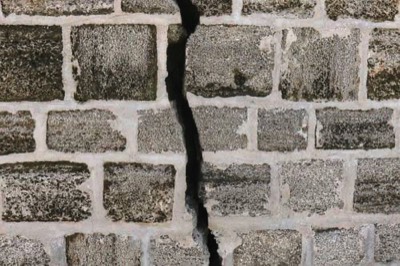We’re All Cracked
St. John’s Anglican Church is an old building and it’s full of cracks. We’ve tried patching them, but they always come back. Back in 2020, I started monitoring one crack to see what was going on. We were still in drought and, at the time, it was 3mm wide. Over the next few months it opened up to over 4mm. But then we had a wet year. At my most recent check, the crack had reduced to just over 1mm wide.
Are there any lessons we can learn from this? Yes, we can accept that we’re getting old and choose to age gracefully rather than slapping on more filler and frantically trying to cling on to the illusion of youth. Good advice but not particularly profound.
Another way we could go is to use this as an analogy for ourselves. As people, we’re full of cracks. These are the result of the pressures and stresses, the struggles and disappointments, the losses and the pains, of life in this world. In fact, the more we’ve lived, the more cracked we are. Like St. John’s, the cracks don’t mean that we are structurally unsound and likely to collapse at any moment, but they are real. In the good times, they’re almost invisible and have little effect. It’s the difficult times, the times of drought in our lives, that cause them to open up and us to relive some of the old pains.
Last week I read a wonderful passage from the bible. The Old Testament prophet Isaiah passed on this invitation from God, “Come, all you who are thirsty, come to the waters; and you who have no money, come, buy and eat! Come, buy wine and milk without money and without cost.” (Isaiah 55:1) There is the antidote to spiritual drought.
And how can we do that? I found the answer in the New Testament. Ask Jesus. He said to one woman, “If you knew the gift of God and who it is that asks you for a drink, you would have asked him and he would have given you living water.” (John 4:10)
Will that make the cracks go away? Not entirely in this life. But just as the moisture level in the soil impacts the cracks at St. John’s, causing them to open and close, so the spiritual water in our lives impacts the cracks in us as people. That’s something worth thinking about.
Neil Percival
Are there any lessons we can learn from this? Yes, we can accept that we’re getting old and choose to age gracefully rather than slapping on more filler and frantically trying to cling on to the illusion of youth. Good advice but not particularly profound.
Another way we could go is to use this as an analogy for ourselves. As people, we’re full of cracks. These are the result of the pressures and stresses, the struggles and disappointments, the losses and the pains, of life in this world. In fact, the more we’ve lived, the more cracked we are. Like St. John’s, the cracks don’t mean that we are structurally unsound and likely to collapse at any moment, but they are real. In the good times, they’re almost invisible and have little effect. It’s the difficult times, the times of drought in our lives, that cause them to open up and us to relive some of the old pains.
Last week I read a wonderful passage from the bible. The Old Testament prophet Isaiah passed on this invitation from God, “Come, all you who are thirsty, come to the waters; and you who have no money, come, buy and eat! Come, buy wine and milk without money and without cost.” (Isaiah 55:1) There is the antidote to spiritual drought.
And how can we do that? I found the answer in the New Testament. Ask Jesus. He said to one woman, “If you knew the gift of God and who it is that asks you for a drink, you would have asked him and he would have given you living water.” (John 4:10)
Will that make the cracks go away? Not entirely in this life. But just as the moisture level in the soil impacts the cracks at St. John’s, causing them to open and close, so the spiritual water in our lives impacts the cracks in us as people. That’s something worth thinking about.
Neil Percival
